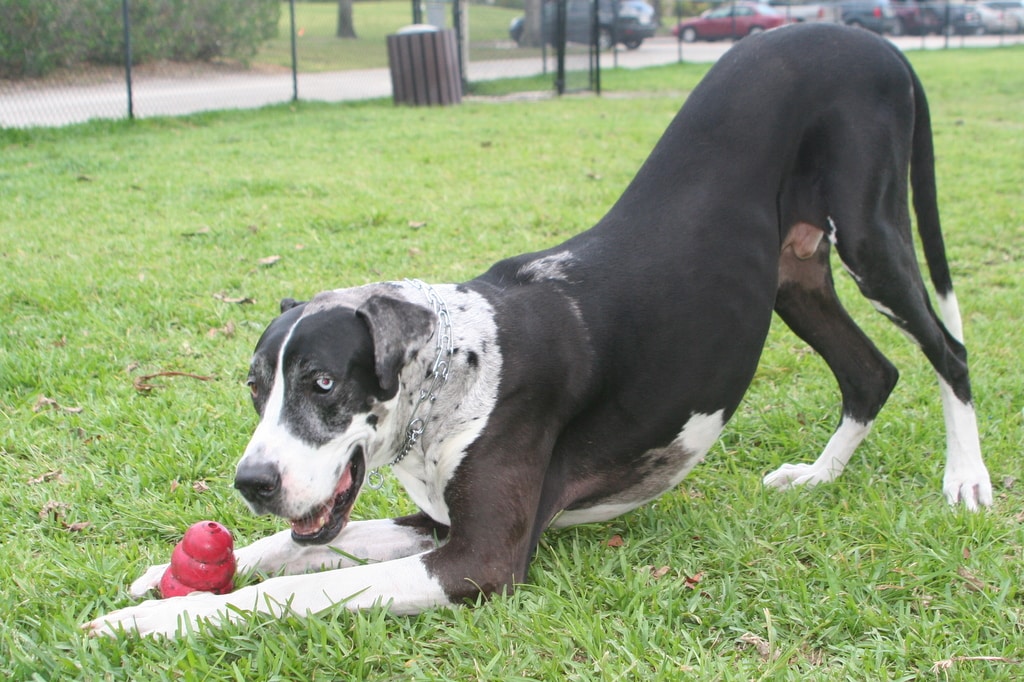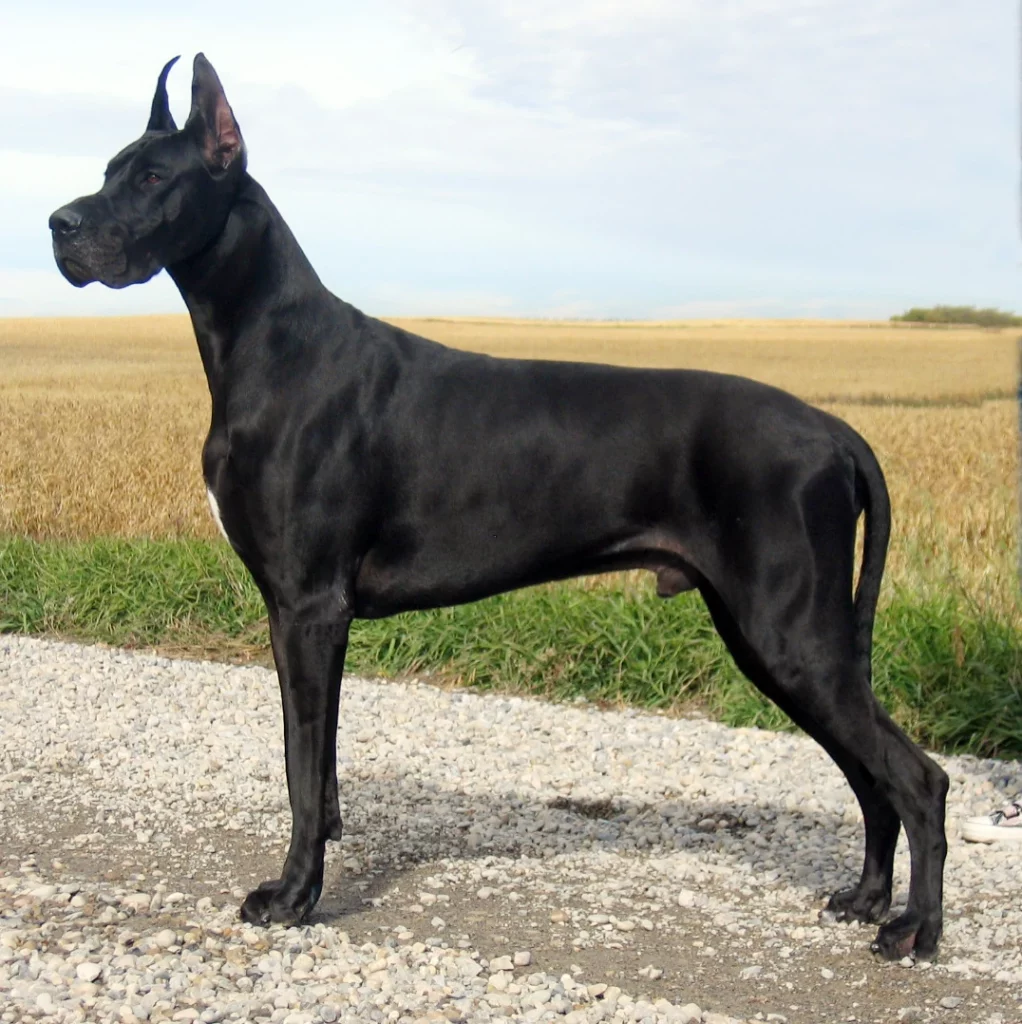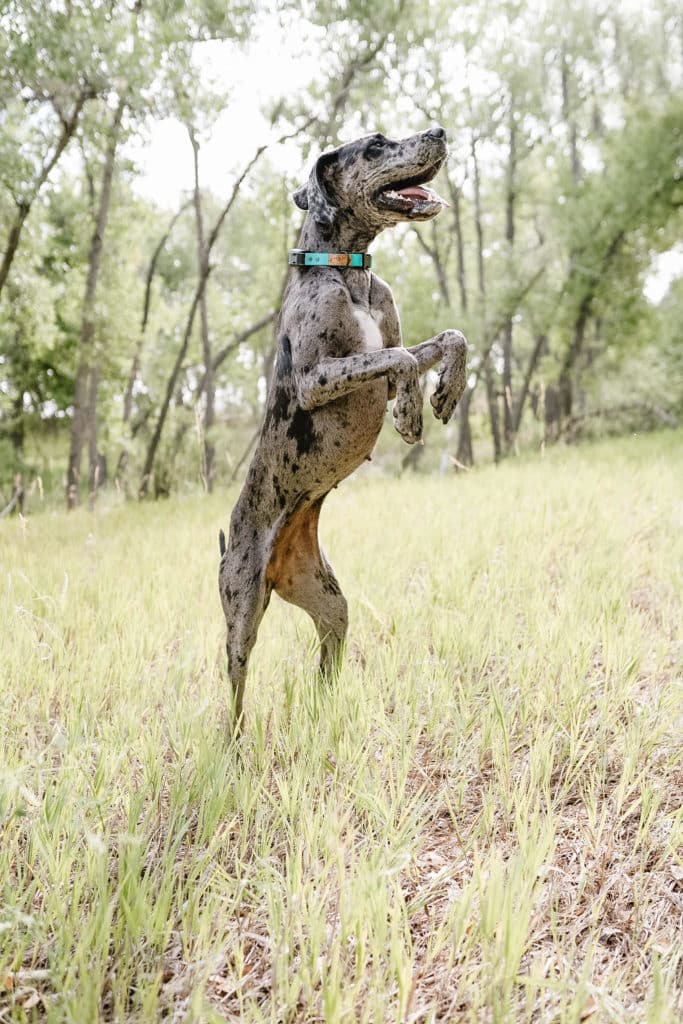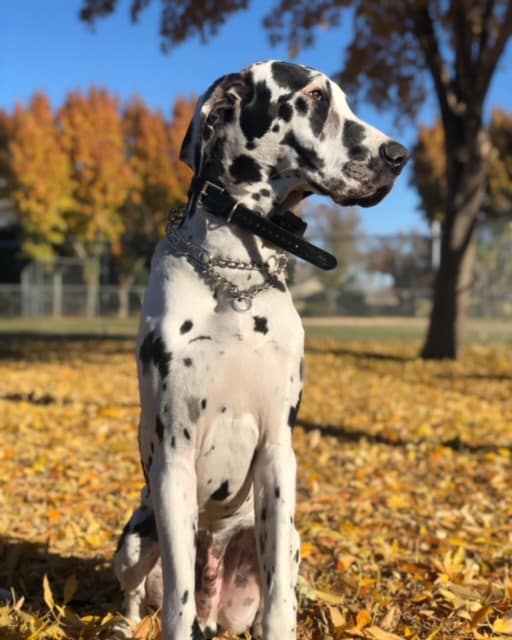It can be stressful to find and choose the best dog trainer for your Great Dane or giant breed dog!
Training is so important, especially with these big dogs. An untrained, under-socialized giant dog may be destructive and can be a danger to you and to the people around you. Good training starts on day one and never stops; all big dogs should be taught that pulling, lunging, jumping and running away are never acceptable.
The confusing part, however, is that there are many schools of thought when it comes to how to train dogs and teach them these important skills.
When it comes to training your Great Dane, you want to be sure that you find and choose the right dog trainer to help you. You want somebody who is thoughtful, educated, up-to-date, humane and driven by real behavior science!
We are here today with some GREAT info, including our honest take on different training methods, tools and more.

Dog Training Methodologies
Many trainers use methods that are unfair to dogs, ineffective, frustrating, or punitive.
It doesn’t matter if they label themselves ‘positive’, ‘balanced’, or ‘natural’, you’re going to run into people who are not operating as ethically or humanely as they should.
The primary core training methods run a spectrum and include:
Force Free / Purely Positive
Balanced
Natural / Dominance / Alpha
Compulsion / Koehler / Old School
Here are a few tips on how to find and choose a humane dog trainer for your Great Dane!

Force-Free & Purely Positive Dog Training
Positive reinforcement and ‘force-free’ dog training seek to utilize treats, praise, and play without corrections to teach all behaviors. This sounds amazing and has its merits, however, this method is also highly restrictive for many dogs.
In ‘positive-only’ dog training, the use of corrections and most tools is prohibited, leaving dog owners with only one other choice when it comes to reducing unwanted behaviors.
Restrictions to freedom, movement, and autonomy that often last a lifetime are key principles in this method.
With all unwanted behaviors, you either have to either correct them or manage them. Management is a form of punishment that can be needlessly restrictive, confusing, and inhumane for some dogs.
REAL LIFE EXAMPLE:
In force-free/positive training, if a dog jumps a fence, positive reinforcement (to increase the value of staying in the yard) will be paired with a loss of freedom (to decrease the chance of recurrence). A long leash may be used, and no corrections are allowed. The fence may also be made more secure.
To put it simply, ‘Force-free’ trainers will only use management and physical restraint, often ongoing, to address unwanted or dangerous behaviors.
Positive reinforcement itself is wonderful and backed by science; you should always use positive reinforcement to teach new behaviors such as leave it, wait, heel, sit, down, and come.
When it comes to addressing behaviors such as lunging, barking, running away, or jumping the fence however, you can see how the method of ‘positive-only’ may fall short and can even be dangerous.
Many extreme force-free and positive-only trainers will adhere to self-made guidelines and refuse to make humane, common sense accommodations for certain dogs.
Examples include:
- Refusing to use a gentle, modern E-Collar on a deaf dog for recall
- Requiring a harness on all dogs, even a 3-legged dog whose body doesn’t fit naturally in one
- Not allowing the use of bitter apple spray to deter a dog from chewing itself
- Putting fence jumpers on a restrictive long leash for life instead of considering a wireless fence or E-Collar system
- Keeping cat-chasers, tire-chasers, jumpers, humpers, barkers, runners, rough players, and chicken killers isolated from freedom, family life, socialization, and the yard to avoid having to use corrections
- Will prescribe behavioral euthanasia before allowing you to seek a second opinion from a balanced dog trainer
Force-Free and Purely Positive red flags
Run from any force-free or positive trainer who shows any of the following red flags:
- Claims to be ‘science based’ (this is an unregulated marketing term, often contradictory in this context as it is scientifically impossible to ONLY use ‘positive reinforcement’)
- Spends a lot of time bashing other trainers, tools, and techniques (MAJOR red flag!)
- Encourages you to always take a long-haul ‘positive-only’ approach, even if doing so seems to be extremely restrictive, confusing, and frustrating to you and your dog
- Won’t allow you to use any kind of correction, corrective action or appropriate tool, even if the dog is doing something dangerous, damaging, rude, or destructive to himself, to you or to others
- Encourages you to ignore professional veterinary advice when it comes to things such as nutrition, wound care and medications
- Relies heavily on front-clip harnesses or head collars (often while still claiming to be ‘force-free’ and ‘science based’)
- Blindly promotes the idea that all ‘balanced’ training, prong collars, flat collars, and modern E-Collars are ‘aversive’ and ‘abusive’
- Are unable to make a notable, reliable, lifelong, positive difference in dogs who have difficult unwanted, dangerous or rude behaviors, especially when the end recommendation is to add additional restrictive management or seek behavioral euthanasia
- The dogs they train are over-excitable, unable to ever be off-leash, anxious/frustrated, and/or have to be managed to prevent jumping, leash reactivity, chasing or otherwise
If you want to work with a force-free or positive dog trainer, ask lots of questions! There are some amazing positive trainers out there, but you must do your research and avoid the extreme version of this training method.

Balanced Dog Training
Balanced training means to use positive reinforcement, corrections and management as needed. Balanced training is positive reinforcement training with more options.
REAL LIFE EXAMPLE:
In balanced training, if a dog jumps a fence, positive reinforcement (to increase the value of staying in the yard) will be paired with a correction (to decrease the value of jumping out of the yard) or wireless fence system. The fence may also be made more secure.
Hence the word ‘balance’.
Like positive-only training, balanced training runs a spectrum from trainers who are mostly positive but utilize spare corrections as needed, to trainers who rely heavily on strict boundaries, routine, structure and corrections.
This makes it that much more difficult to find an ethical trainer! Ideally, you want to stick with balanced trainers who fall clearly on the ‘positive’ side of things.
Properly used prong collars and modern E-Collars are NOT abuse. Do not fall for inflammatory marketing from people who don’t know how to use those tools correctly.
Balanced dog trainers are more likely to choose prong collars and E-Collars, though they may also use head collars at times. The best balanced trainers use a training method that relies heavily on positive reinforcement, and will utilize modern E-Collars to release dogs from constant physical restraint.
We recommend modern balanced training for all dogs. All large and giant breed dogs should ideally be trained to at least CGC level (Canine Good Citizen) and have excellent off-leash obedience skills using a modern E-Collar.
Large and giant breed dogs are prone to orthopedic issues. The Modern E-Collar is the only training tool available that unlike a harness or flat collar can cause absolutely no physical damage to your dog’s physical structure, gait, neck or trachea.
Balanced Dog Trainer Red Flags
Run from any balanced dog trainer who shows these red flags:
- Wants to put an E-Collar or Prong collar on your dog so they can use harsh punitive ‘yank and crank’ training methods
- Uses any training technique that clearly makes your dog fearful, scared, or distressed
- Tells you to dominant, intimidate, alpha roll, pin, scold, kick, or roughly handle your dog
- Spends more time saying NO than saying YES
- Forces your dog into extended down-stay position and may use a shock collar at aversive levels to force compliance
- Uses penny cans or bags of chains to scare or startle your dog
- Floods dogs by deliberately exposing them to triggers
- Quotes Cesar Milan or Jeff Gellman
- Is constantly tugging, pulling and snapping a slip lead around your dogs neck
- Doesn’t use treats and/or claims that treats are ‘bribery’
- Tells you that all bad behavior and reactivity is the result of defiance, dominance or stubbornness
- Encourages you to ignore veterinary advice related to nutrition
- The dogs they train appear shut down, fearful, short-tempered, or nervous
We recommend searching the IACP certified trainer database to find a safe, humane and professional qualified balanced E-Collar trainer for your Great Dane or giant breed dog.

Natural/Dominance/Alpha Dog Training
Alpha dog training (often called ‘Natural’ or ‘Dominance’) is an outdated training method that has very little scientific backing to it.
This training method was made popular by Cesar Milan, and involves a lot of hovering, intimidations, corrections and forward body language.
REAL LIFE EXAMPLE:
In alpha training, if a dog jumps a fence, the dog will be harshly corrected at the fence line with neck jabs and leash pops. Additionally, steps will be taken to ‘lower the dog’s status’ through other forms of intimidation and force.
‘Be the Boss’, ‘Be the Alpha’, and ‘Be the Pack Leader’ are common phrases, based on incorrect observations that were made of a captive wolf pack.
Trainers who subscribe to this method generally believe that treats and positive reinforcement are forms of bribery that should be used sparingly, and that a well trained obedient dog is always in a state of ‘calm submission’. For many dogs, ‘calm submission’ is actually a form of behavior suppression, fear and anxiety.
Additionally, they believe that behavior problems are easily solved by putting the dog into a lower pack position, and may teach you to use ‘woo’ training techniques such as:
- Walking through doors before your dog
- Keeping your dogs eye level below yours
- Eating food first, in front of your dog before serving your dog his food
- Pretending to eat your dogs food
- Biting your dogs ear or neck
- Neck jabs (‘Alpha dog corrections’)
Alpha theory is considered laughable in the science of modern dog behavior.
Alpha Dog Training Red Flags
Run from any ‘alpha’, ‘natural’ or ‘dominance’ dog trainer who:
- Says that aggression is the result of a lack of leadership
- Tells you to stick your hands in your dogs food bowl to show them that you are ‘the boss’
- Uses intimidation to make your dog appear ‘calm and submissive’
- Tells you to choke, jab, neck jab, scruff, shake, hit, kick or roughly handle your dog or puppy
- Shows you how to use an ‘alpha roll’ to pin your dog down until they give up
- Uses physical pressure and force to keep your dog in a sit, down or stay
- Says ‘PSSHhhhhTTTTT’
- Uses a lot of leash pops, scolding and harsh corrections
- Uses flooding techniques until your dog ‘gives up’ and is no longer ‘dominant’
- Shows ‘quick fix’ videos
- Tells you to ignore the advice of your veterinarian
Dog training techniques that rely on outdated notions of being the “alpha” and use confusing, punitive tactics may harm your bond with your dog.

Compulsion / Koehler / Old School Dog Training
Finally, this method of dog training goes back to the days where a lot of compulsion and force was used.
REAL LIFE EXAMPLE:
In compulsion training, if a dog jumps a fence, the dog will be harshly corrected at the fence line, and the use of a livestock hot wire may be prescribed. The dog may also then be put on a leash or chain (not unlike we see in ‘force-free’ training).
A compulsion dog trainer will teach ‘sit’ by pushing down on the dog’s rear end until they submit by sitting. They will teach ‘heel’ by using pressure into a slip lead to force the dog by their side.
Forced compliance is the name of the game with this method. The use of slip leads and choke chains are common. You are most likely to happen upon Koehler method trainers in the hunting dog community or when seeking the help of trainers that have ’30 years of experience’.
Compulsion Trainer Red Flags
- Tells you that they can fix all behavior problems quickly
- Uses a slip lead or chain to pop, pull, tug, and move your dog around
- May keep a sharp tack in one hand and use it to pinch the ear when forcing compliance
- Doesn’t want you to talk to your dog or show affection
- Encourages the use of physical handling and manipulation
- Implies that modern dog training and ‘positive reinforcement’ is a scam
- Has dogs that appear robotically obedient and that may lack enthusiasm and spark

How to find a trainer for your Great Dane
We highly recommend hiring a modern balanced dog trainer who uses a lot of positive reinforcement.
This type of trainer will use management to avoid needless punishment, but they’re not afraid to use appropriate corrections when necessary. Balanced dog training avoids the extremes, which can be harmful and frustrating to your pet.
A qualified balanced trainer will also show you how to humanely and properly use a modern E-Collar for off-leash training, which is the necessary to protect your dogs orthopedic health.
We recommend searching the IACP database for a humane, positive balanced trainer in your area.


Questions to ask your dog trainer
Here are some questions to ask potential trainers:
- What happens when my dog does something right?
- When my dog does something wrong, what do you do?
- Can you tell me about the tools you often recommend, how they work and why you use them?
- Are you able to share legitimate references with me?
- What are your goals for the dogs you train?
- Do you offer CGC testing, scent work, Snake Avoidance, Fitpaws or any other enrichment classes?

Great Dane training should be fun!
When it comes to finding a trainer for your Great Dane, be sure to do your research.
There are a lot of trainers and franchise training companies out there who claim to be experts, but not all of them will be a good fit for you and your dog.
If you have questions about balanced dog training, E-Collars, prong collars, or more we are here for you!


Leave a Reply